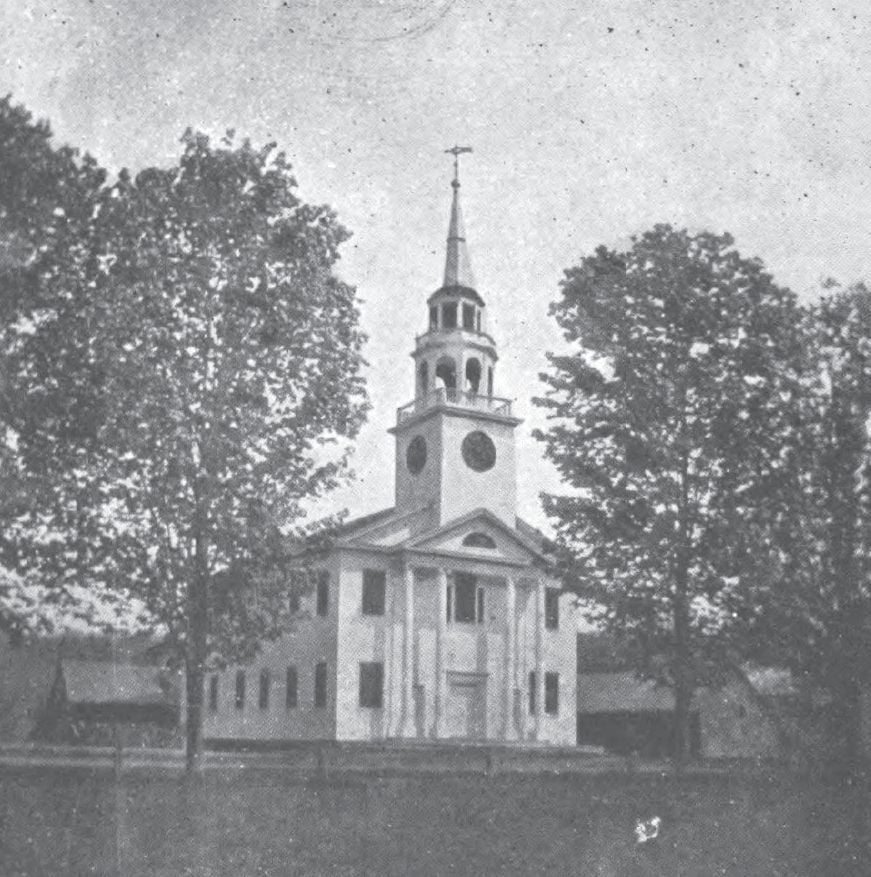The Congregational Church of Norwich is among the oldest of the Congregational churches of Vermont, only four others having preceded it in the date of their organization, viz.: those of Bennington, Newbury, Westminster, and Windsor. It was the earliest and for many years the only ecclesiastical organization in town. Some of the first settlers had been members of this church in Connecticut before settling here. These would naturally associate themselves for public worship, and as early as June, 1770, by the aid, it is said, of Reverend Peter Powers, the pioneer minister of Newbury, the nucleus of a church was gathered, consisting at the beginning of about a dozen members. Joseph Smalley and John Burnap were the first deacons. August 31, 1775, Reverend Lyman Potter, a native of Plymouth, Conn., and a graduate of Yale College in 1772, was installed over the church, at that time consisting of thirty-six persons. Before the settlement of Mr. Potter, the Norwich people had attended religious services at North Hanover and at the College. Women and children walked from three to six miles to attend these meetings. Mr. Potter was ordained in the open woods, upon the site of the old cemetery on the hill, near the place where the first meeting house was built some years later.

Up to the year 1784, meetings were held at private houses, barns, or in the open air, according to the season or as seemed most convenient. A large barn erected by Colonel Peter Olcott was much used for this purpose. In the year mentioned the meeting house was so near complete as to be used for meetings. The ministry of Mr. Potter continued twenty-six years, until his dismissal in 1801. Two revivals of religion are mentioned as occurring during his pastorate, the first son after his settlement when about forty persons were added to the church, and the second in the years 1780-81, when an extensive revival prevailed at Dartmouth College and in all the towns of the region. At the time of his dismission the total membership was about one hundred. Only a few fragments of the church records during Mr. Potter‘s ministry have been preserved. These with the somewhat fuller records of his successors in the old North Church have recently been deposited in the office of the town clerk.
After the dismission of Mr. Potter in 1801 the church was without a settled minister for about three years, during which time preaching was supplied chiefly by Professor Shurtleff, then a tutor in Dartmouth College and by Reverend Mr. Waters. Sept. 4, 1804, Reverend James W. Woodward was installed over the church and continued to act as pastor until June 8, 1821. During the period of Mr. Woodward‘s service many of the original and early members of the church were removed by death, and there was a large emigration from town to northern Vermont, to New York State and the farther West, especially from among the young people. There were several seasons of unusual interest but no general revival of religion while Mr. Woodward was pastor. In 1808, nineteen were added to the church and in 1817, fourteen; and about fifty were admitted by profession during his ministry. The benevolent disposition and scholarly graces of Mr. Woodward made him universally respected and beloved. A man of singular purity of character and life, his name still lingers among the older inhabitants of the town, a tender and fragrant memory.
Towards the close of Mr. Woodward‘s ministry an unfortunate controversy arose respecting the location of a new meeting house, which resulted after a heated contest and considerable bitterness of feeling in the building of two church edifices, one near the site of the first meeting house, and the other at Norwich Plain, then beginning to put on the appearance of a rising country village and to aspire to become the business center of the town. The new meeting houses were each completed for occupation in the latter part of the year 1817, the one at the Plain being dedicated Nov. 20th, and the other Jan. 1, 1818. On both occasions the dedicatory sermon was preached by Mr. Woodward. The division of the congregation soon led, however, to the formation of a new church, known as the South Congregational Church of Norwich, which was organized June 19, 1819, with eleven members. Soon after, about twenty more were dismissed from the North Church (as the original church was thenceforward called) to join the church at the Plain, and further accessions in the years closely following raised the new organization and allied society to very respectable numerical and working strength. Still, for nearly a score of years later the North Church appears to have held the precedence in numbers and in the support of the old families of the town. Mr. Woodward was dismissed from this church June 8, 1821, having been settled nearly seventeen years. The membership was then about the same as at the time of his settlement, one hundred.
